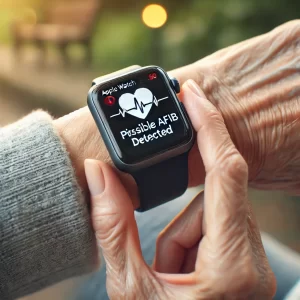Apple Watch and Atrial Fibrillation: A Modern Approach to Detection
With the rise of wearable technology, devices like the Apple Watch have become valuable tools in detecting abnormal heart rhythms, including atrial fibrillation (AFib). If your Apple Watch alerts you to AFib, it’s important to consult with a healthcare provider to confirm the diagnosis.
How Does the Apple Watch Detect AFib?
The Apple Watch employs two key technologies to monitor heart rhythms:
- Photoplethysmography (PPG):
This optical sensor, located on the back of the watch, measures subtle changes in blood flow. The PPG monitors your pulse continuously, and if it detects an irregular rhythm multiple times, it triggers a notification, suggesting the possibility of AFib. PPG helps in passive monitoring, alerting users without the need to perform an active test. - Electrocardiogram (ECG):
 If an irregularity is detected by PPG, the Apple Watch prompts you to confirm it by recording an ECG. With the ECG app, you place your finger on the crown for 30 seconds to capture a single-lead ECG, which provides a more precise assessment. This active check improves accuracy and helps diagnose AFib more confidently.
If an irregularity is detected by PPG, the Apple Watch prompts you to confirm it by recording an ECG. With the ECG app, you place your finger on the crown for 30 seconds to capture a single-lead ECG, which provides a more precise assessment. This active check improves accuracy and helps diagnose AFib more confidently.
Together, PPG and ECG provide a powerful combination: passive detection through regular pulse monitoring and active confirmation using the ECG app when irregularities arise.
How Accurate is the Apple Watch in Detecting AFib?
The Apple Watch is a valuable screening tool, but it isn’t perfect. Here’s what to know:
- Younger individuals (under 55) who wear the Apple Watch typically have a low risk of AFib. This means that false positives—alerts that suggest AFib when it isn’t present—can occur.
- In fact, physician-scientist Sekar Kathiresan estimates that alerts may be incorrect 45% of the time.
That said, when the watch captures an ECG tracing, the accuracy improves significantly, making it a valuable diagnostic tool for healthcare providers.
When I am evaluating a patient that had afib detected by the apple watch my first step is to analyze the tracings they have recorded. The quality is often good enough to confirm the diagnosis. Other tests may be requested to to improve the accuracy and understand how often you are having Afib.
What Should I Do if My Apple Watch Detects AFib?
- If your Apple Watch alerts you to an irregular rhythm, you should use the ECG feature and record the rhythm. This is a very useful feature of the apple watch and frequently leads to the diagnosis of AFib and other arrhythmias. The recording will be stored in your smartphone and can be shared with your physician
- Consult a physician—preferably a cardiologist or electrophysiologist like Dr. Jose Osorio
- The first step for most will be to use a patch monitor, which can record your heart rhythm continuously for weeks at a time. And it later can be analyzed for signs of Afib or other irregular heart rhythms. If AFib is diagnosed, most patients will need other tests, such as a stress test and echocardiogram – but that is an individualized decision.
- If you are diagnosed with atrial fibrillation, there are many treatment options today.
- My approach is to individualize the treatment to the patient’s goals.
- There are important steps to take for every patient to achieve the best results.

How is Atrial Fibrillation (AFib) diagnosed?
Atrial fibrillation is diagnosed with an analysis of your heart rhythm, done with an ECG
- In-Clinic ECG: Performed using a 12-lead ECG with 10 electrodes to give a detailed view of your heart’s electrical activity.
- Portable Monitors: Also called patch monitors and holters, they can be worn at home for a few days to detect irregular rhythms.
- Implantable Loop Recorders: Used in cases where long-term monitoring is needed, with devices lasting up to 3 years.
Paroxysmal AFib can make diagnosis tricky, as episodes come and go. Long-term monitoring helps capture these irregularities to ensure an accurate diagnosis.
Why Early Detection is Critical
AFib is a serious condition that can lead to stroke, heart failure, and other complications if left untreated. Wearable technology like the Apple Watch can help catch these irregularities early, potentially reducing the risk of more severe outcomes.
To learn more about how AFib increases your stroke risk, visit our AFib & Stroke Risk page.
Next Steps if your Apple Watch has alerted AFib
If you’ve received an AFib alert from your Apple Watch, the next step is to seek professional medical advice. At The AFib Clinic, we provide personalized care and offer both in-person and telehealth consultations. Our goal is to tailor treatment to your unique needs, ensuring that you achieve the best possible outcomes.
Learn More About AFib
Explore these educational resources on our website:
-
What is AFib?
-
What Type of AFib Do You Have?
-
AFib Ablation
-
You have been diagnosed with Afib? Now what should you do?
-
What are the treatment options for afib?
-
What is afib ablation?
If you would like to learn more about Afib, please check out our website and feel free to contact us to schedule an online or in-person evaluation.
Jose Osorio, MD
Miami, FL
1-855-444-AFIB
Other Posts:
AFib Ablation: Advanced Atrial Fibrillation Treatment in Miami | The AFib Clinic
